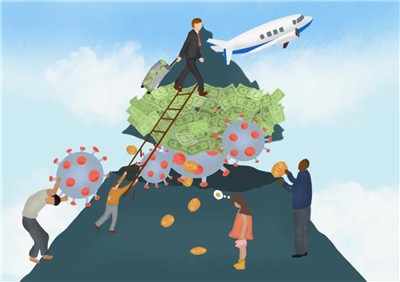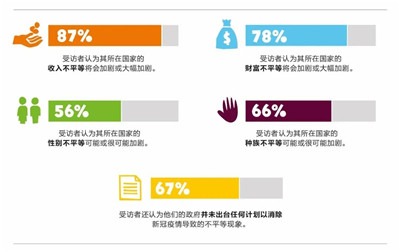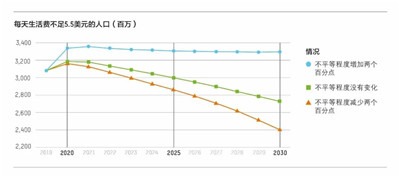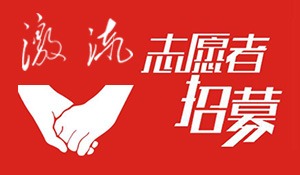以下内容选自乐施会2021达沃斯报告《不平等病毒》
完整版PDF下载https://www.oxfam.org.cn/index.php?c=article&id=4079
 手绘图作者/莊淯棻
手绘图作者/莊淯棻
新冠疫情令世界各国站在巨大的健康和经济危机的边缘。有充分证据表明,早在新冠疫情到来之前,贫富差距已经达到极高水平,而现在,除非针对疫情采取紧急行动,否则新冠疫情几乎会同时加剧每个国家的经济不平等程度,这也是有史以来首次出现这种情况。
疫情几乎加剧了所有国家的经济不平等程度
21世纪以来,社会顶层阶级财富不断积累。在2008年金融危机之后的十年里,亿万富翁的总数几乎翻了一番,2017至2018年,平均每两天就有一个新的亿万富翁诞生。[i]
最富有人口与其他人口之间的鸿沟之所以日益扩大,部分是因为收入不平等程度持续居高不下。2015年以前的25年中,世界上大多数人口所生活的国家的收入不平等程度都在加剧。[ii]世界不平等实验室(World Inequality Lab)的数据显示,1980至2016年,全球收入每增长1美元,最富有的1%的人口便获得了其中的27美分。[iii] 相当于底层50%人口所获份额的两倍多。
这种极端的不平等意味着,新冠疫情爆发时,数十亿人已经生活在危机边缘。他们无法获取任何资源或支持来度过这场危机带来的经济和社会风暴。超过30亿人得不到医疗服务,四分之三的工人无法享受失业救济金或病假工资等社会保障,在低收入和中低收入国家,半数以上工人陷入工作贫困,也就是说即使有固定工作仍处于贫困状态。
新型冠状病毒导致富者更富
目前全球正经历的经济危机,其程度规模只有1930年代的大萧条可与之相提并论。据世界银行预测,2020年新冠疫情导致全球GDP收缩约5.2%,遭受影响的国家总数是自1870年以来最多的一次。[iv]商品和石油价格下跌,加上全球价值链的供给侧震荡,也加剧了这场经济危机。然而,此次危机对不同群体带来的影响并不相同。
2020年3月,全球股市遭受了百年来最严重的震荡,价值数十亿美元的金融资产被摧毁。不过从那以后股市得到良好恢复,由于世界上最富有的人把他们大部分的财富都投资于股票和期权,他们的财富也随之重获保障。前1000位亿万富翁(一个以白人男性为主的小群体)的财富仅在短短9个月内就恢复到了疫情爆发前的水平。[v][vi]相比之下,2008年金融危机后,亿万富翁的财富用了5年时间才恢复到金融危机前的高点。[vii]当实体经济正面临百年以来最严重的萧条时,股市却在蓬勃发展,这很大程度上得益于各国央行采取了重量级的措施。数十亿美元的大幅注资有助于防止股市崩盘,但另一方面,各国政府对实体经济的支持却显得断断续续、极不稳定。[viii]
从2020年3月18日至11月30日,全球亿万富翁的财富增长达到3.9万亿美元的惊人水平。[ix]他们的总财富现在已达11.95万亿美元,相当于二十国集团为应对疫情所花费的全部资金。[x][xi]在全球最富有的50位亿万富翁中,只有三人的财富在疫情期间缩水,损失了30亿美元。这一时期财富增长最快的两位亿万富翁活跃在科技和汽车、电池生产和航天行业:埃隆·马斯克(Elon Musk)的净财富增加了1042亿美元,杰夫·贝索斯增加了705亿美元。世界上最富有的10位亿万富翁的财富在此期间增加了5400亿美元。[xii]
全球最大的几家企业正在向股东输送数十亿美元的利润,进一步给全球最富有的亿万富翁们带来了一笔横财。[xiii]
亿万富翁与他们的雇员
自疫情爆发以来,许多大企业将利润置于工人安全之上,挤压供应链以降低成本,并利用其政治影响力来制定应对政策。从结果上看,大型企业利润飙升,推动了富有股东的财富增加,而中小型企业、低工资工人和妇女却在危机中首当其冲。[xiv]
虽然排名美国前25位的大公司在2020年的利润将比前一年增长11%,但美国小企业在今年第二季度可能会损失超过85%的利润。[xv]
穆克什•安巴尼(Mukesh Ambani)是印度首富,他名下的信实工业(Reliance Industries)专门从事石油、零售和电信业务。2020年3月至10月,他的财富翻了一倍多,达到783亿美元,在21世纪富豪排名榜上的排名从第21位跃升至第6位。在此期间,安巴尼的财富在短短四天多时间里的增长平均值超过了信实工业19.5万名雇员年薪的总和。[xvi]
2020年9月,全球首富杰夫·贝索斯在2020年3月至8月积累的财富足以向亚马逊公司的87.6万名员工发放每人10.5万美元的一次性奖金,而即便发了这么多钱,他仍然像疫情爆发初期那般富有。[xvii]
有证据表明,全世界最富有的人都逃过了疫情带来的最严重冲击。在英国,当低收入家庭在封城期间陷入负债境况时,最富有的20%的家庭却因此节省了300亿美元。[xviii][xix]当黎巴嫩面临经济崩溃时,超级富豪们在山区度假胜地寻求慰藉。[xx]当商业旅行被禁止后,全球私人飞机的销量飙升。[xxi]有报道称,世界上的富人们为了应对封城,将他们大部分资金转移到了避税天堂。[xxii]
各国政府的救助政策和一揽子财政救援计划却也支持了资产雄厚同时是高污染的行业。例如,截至2020年11月,作为经济复苏计划的一部分,二十国集团成员国承诺向石化燃料行业提供总计2510亿美元的资金支持。[xxiii]这种举措保护了这些公司及其富裕的股东免受危机的最坏影响,并将他们的损失社会化——即通过由纳税人承担对企业的补贴或救助,将这些损失转化为整个社会必须承担的责任——同时,这些企业还在继续破坏环境。
新型冠状病毒导致穷者更穷
当全球的亿万富翁们变得越来越富有,生活在贫困中的人们将会因为新型冠状病毒而变得更加贫穷。最近的一份研究估算,全球每天生活费低于5.5美元的人口数量可能会增加2亿,达到5亿之多。[xxiv][xxv][xxvi]发展倡议(Development Initiatives)表示,几乎所有国家的最贫困人口的收入,都因为新冠疫情而出现下降。[xxvii]
受疫情影响新增的贫困人口中,超过三分之二分布在南亚、东亚和太平洋地区。[xxviii]如上所述,尽管拉美和加勒比地区的亿万富翁财富在激增,但据估计,到2020年,这些地区仍将有4000万人失业,还有5200万人可能会变得贫困。[xxix]新型冠状病毒暴露出的残酷现实是全球大多数人的生计都变得更加不确定。在正常情况下,大多数人的收入仅略高于贫困线。在全球范围内,56%的人口每天的生活费在2美元至10美元之间。[xxx]在中低收入国家中,有一半以上的工人处于工作贫困状态。[xxxi]他们的工作得不到劳动保护,也得不到失业救济或支持。这意味着当许多国家在一夜之间实施封城、全球供应链陷入停顿以及新型冠状病毒引发了相关的经济危机时,他们将失去收入来源并迅速面临食不果腹的问题。
大多数被迫陷入贫困的人是非正规就业人员。[xxxii]他们被排除在社会保护、社会支持体系和获得信贷的机会之外。在危机时期,他们还常常必须以相当于赠送的低价出售自行车或牲畜等资产,这使得他们很难恢复元气,并造成了可能持续数十年的贫困陷阱。[xxxiii]处于经济顶层的人感受不到这种贫困陷阱,这意味着即使经济快速恢复增长,除非采取具体行动,否则我们将会预见贫困群体经济状况的恢复速率更加缓慢,贫困差距拉大的结果。由于女性、青年、儿童、原住民和异地(跨境)务工人员更有可能在非正规部门工作,因此他们将格外受到这种不平等现象的影响。
 图片孟加拉国考克斯巴扎罗兴亚难民营(Cox’s Bazar Rohingya refugee camp)中,努尔·贾汉(Nur Jahan)和她的女儿伊斯玛特(Ismat)正在帐篷旁的狭窄巷子里散步。为保护受访者,称呼均为化名。摄影:Fabeha Monir /乐施会
图片孟加拉国考克斯巴扎罗兴亚难民营(Cox’s Bazar Rohingya refugee camp)中,努尔·贾汉(Nur Jahan)和她的女儿伊斯玛特(Ismat)正在帐篷旁的狭窄巷子里散步。为保护受访者,称呼均为化名。摄影:Fabeha Monir /乐施会
艰难的经济前景
国际货币基金组织估计,近年猪流感(H1N1)和寨卡病毒(Zika virus)等流行病导致受影响国家的不平等水平增加了1.3%。[xxxiv]然而,由于应对新冠疫情所需要的限制措施更为广泛,该组织预测此次疫情的影响将会大得多。[xxxv]国际货币基金组织和世界银行都强烈担心,这场危机将导致世界各国的不平等加剧。[xxxvi]经济合作与发展组织与瑞士信贷(Credit Suisse)在其《2020年全球财富报告》[xxxvii](2020 Global Wealth report)也表达了同样的担忧。[xxxviii]
这是首次出现几乎所有地区的不平等现象都同时加剧的情况吗?
关于不平等趋势性变化的历史记录最早可追溯至20世纪初的税收记录。[xxxix]几乎所有有记录的富裕国家的不平等程度都在第一次世界大战(1914年-1918年)之前达到了最高水平,在那之后不平等程度的发展趋势变化极大。[xl]“一战”和”二战”后,富裕国家的不平等程度有所下降。从1980年代起,英国和美国等一些国家的不平等程度迅速加深。但在其他富裕国家,例如欧洲大陆和日本,则没有出现如此大的增长。在苏联,不平等现象在冷战结束后急剧加剧。[xli]自1980年开始实行自由市场改革后,中国也出现了不平等现象。[xlii]“二战”期间,南非、阿根廷等几个国家逆势而上,不平等现象加剧。[xliii]在印度,不平等程度在独立后有所下降,但最近又回升到了殖民时代的水平。[xliv]尽管近几十年来大多数国家都呈现出不平等现象加剧的趋势,但也有明显的例外,如拉丁美洲在2000年代的不平等程度便有所下降。[xlv][xlvi]新冠疫情带来的经济冲击在性质上颇为独特:它对不同社会造成的影响是不平等的,但地球上的每个国家又能同时感受到它的影响。[xlvii][xlviii](世界银行)预计所有地区的人均收入都将下降,这是1870年来的首次。[xlix]这意味着,新冠疫情很可能会同时加剧几乎所有国家的不平等现象。这也将是自一个多世纪前有不平等现象记录以来第一次出现这种情况。
为了准备这份报告,乐施会对来自79个国家的295名经济学家进行了调研,其中包括贾亚提·戈什、杰弗瑞•萨克斯和加布里埃尔·祖克曼等。我们请他们对“不平等现象是否会因新冠疫情而加剧”表达看法。我们还问了一些关于收入和财富不平等以及性别和种族不平等的问题。
受访的经济学家中有87%的人预计由于新冠疫情的影响,其所在国家的收入不平等现象将会加剧,甚至大幅加剧。在调查的来自79个国家的经济学家代表中,有77个国家的经济学家持上述观点。在79个国家的受访者中,有71个国家的受访者(78%)认为财富不平等将会加剧或大幅加剧。超过一半的受访者(56%)认为性别不平等可能或很可能加剧,三分之二的受访者(66%)认为种族不平等也会出现同样的情况。三分之二的受访者还认为他们的政府并未出台任何计划以消除不平等现象。
 针对新冠疫情对不平等现象的影响,乐施会对经济学家所做调研的主要结果
针对新冠疫情对不平等现象的影响,乐施会对经济学家所做调研的主要结果
新冠疫情对不平等现象造成影响的早期证据
在大多数国家,衡量不平等的方法在新冠疫情之前就已存在,尽管人们强烈一致地认为世界各国的不平等现象将会加剧,但具体数据才刚刚开始出炉。尽管如此,至少有三份多国调查为我们提供了一些早期阶段新冠疫情对不平等的影响评估。
美洲开发银行(IDB)于2020年4月对17个拉美国家的230540人进行了一项在线调查,结果发现,在2020年1月越是贫穷的人们,(在当期)4月份他们的家庭成员失业的可能性就越大。[l]
德国劳动经济研究所(IZA Institute of Labor Economics)在2020年4月的第三周对中国、意大利、日本、韩国、英国和美国的6082名受访者进行了第二次调研,没有发现收入损失分布不均,但得出的结论是较贫困的人口更多地利用了他们的储蓄来应对新冠疫情造成的影响,而仅次于最贫困人口的五分之一人口预期劳动收入损失更多。[li]与此同时,英国和其他国家的研究发现,由于富裕阶层人群在封城期间无法消费,他们的储蓄水平有所提高。[lii]对一些高收入国家所进行的研究结果显示指出,政府的一揽子刺激计划在防止不平等加剧方面可能会奏效,但上述政府所采取的措施都是临时性的应对策略。[liii]
第三项研究是世界银行针对15个非洲和亚洲国家所开展的一系列电话调查。[liv]其调查始于2020年4月,是分轮次开展进行的。[lv]研究没有发现穷人在面临失业或歇业方面遭遇比中等收入阶层更严重的问题。世界银行的结论是:“中等收入人群更可能从事运输业、酒店业和零售业,这些行业受疫情影响更大,因而中等收入群体在疫情中所遭受的失业或歇业程度与穷人所差无几。”[lvi]
一个初步的结论是,经济危机对穷人的伤害比对富人的更大。较穷的穷人(每天生活费在1.9美元到5.5美元之间的数十亿人)似乎比极端贫困的穷人更能感受到疫情早期的冲击。更能感受到早期的影响。除了短期影响,富裕阶层人群更有可能有足够的资源来恢复元气,而疫情可能对那些靠出售生产性资产和削减食品消费来应对危机的穷人产生持久影响。这些穷人已经永远地离开学校,或者面临他们工作所在的小企业永久性的倒闭。除非政府采取紧急行动,否则这可能会进一步加剧不平等。
如果不平等现象(以基尼系数衡量)在危机后继续加剧,这将对贫困程度产生长期而深远的影响。[lvii]世界银行模拟了危机后每个国家的不平等程度加剧对全球贫困情况的影响。[lviii]他们发现,如果不平等程度增加两个百分点,最坏的情况是全球经济增长收缩8%,那么到2030年,仍将有5.01亿人每天的生活费低于5.5美元。这意味着,十年后的2030年,全球贫困程度仍将高于新冠疫情爆发时的程度,届时仍有33亿人每天的生活费不足5.5美元。相反,如果各国政府采取协调一致的行动,将不平等程度降低两个百分点,那么到2023年,我们就可以恢复到新冠疫情爆发前的贫困水平。到2030年,生活在贫困中的人数将比任由不平等现象加剧的情况下减少约8.6亿人。
 新冠疫情之后的十年里,不平等现象将对全球贫困程度造成怎样的影响?
新冠疫情之后的十年里,不平等现象将对全球贫困程度造成怎样的影响?
如果不采取果断行动,经济不平等程度的持续加深和广度的持续扩大将留下一份具腐蚀性的遗产,对于最贫穷和最边缘化的人口来说尤其如此。正如国际货币基金组织总裁克里斯塔利娜·格奥尔基耶娃所言,“不平等现象的加剧将产生深远的影响……它将导致经济和社会动荡:2020年代这代人将成为新的‘迷惘的一代’,并且他们将在未来数十年里持续感受到后继的影响。”[lix]
编译/香港乐施会;
为保持文字连贯性,编译过程中有删减
[i] M. Lawson et al. (2019). Public Good orPrivate Wealth? Oxfam International. https://oxfamilibrary.openrepository.com/bitstream/handle/10546/620599/bp-public-good-or-private-wealth-210119-en.pdf
[ii]C. Lakner. (2019). A Global View ofInequality. World Bank. http://pubdocs.worldbank.org/en/792141568662759167/World-Bank-Sep-2019-Lakner-2-public.pdf
[iii] World Inequality Lab. (2017). World Inequality Report 2018. https://wir2018.wid.world/
[iv]World Bank. (2020). The Global Economic Outlook During the COVID-19 Pandemic: A ChangedWorld. https://www.worldbank.org/en/news/feature/2020/06/08/the-global-economic-outlook-during-the-covid-19-pandemic-a-changed-world
[v] As of October 31st 2020, more than half ofbillionaires in the top 1,000 were White men. Source: Forbes Real-TimeBillionaires List https://www.forbes.com/real-time-billionaires/’
[vi] P. Espinoza Revollo (2021). The Inequality Virus: Methodology note.Oxfam. See separate download on the page for this publication.
[vii] P.E. Revollo et al (2019) Methodology note. Public Good or PrivateWealth? Oxfam International. https://oxfamilibrary.openrepository.com/bitstream/handle/10546/620599/tb-public-good-or-private-wealth-methodology-note-210119-en.pdf
[viii] D. Swonk, D. Rosenberg, M.A. El-Erian, A.Posen, E. Porter and T. Jackson. (2020). Why Are Stocks Soaring in the Middle of aPandemic?https://foreignpolicy.com/2020/05/29/stock-market-rally-coronavirus-pandemic/
[ix] P. Espinoza Revollo(2021). The Inequality Virus: Methodology note. Oxfam. See separate download on the pagefor this publication.
[x] P. Espinoza Revollo (2021). Ibid.
[xi]O. Celasun, L. Christiansen, and M. MacDonald. (2020). The Crisis is Not Over, Keep Spending(Wisely). IMF Blog. https://blogs.imf.org/2020/11/02/the-crisis-is-not-over-keep-spending-wisely/
[xii] P. Espinoza Revollo (2021). The Inequality Virus: Methodology note.Oxfam. See separate download on the page for this publication.
[xiii] U. Gneiting, N. Lusiani and I. Tamir.(2020). Power, Profits and the Pandemic:From corporate extraction for the few to an economy that works for all.Oxfam International. https://www.oxfam.org/en/research/power-profits-and-pandemic
[xiv] U. Gneiting, N. Lusiani and I. Tamir.(2020). Ibid.
[xv] Oxfam America. (2020). Pandemic ProfitsExposed. Media briefing, 22 July 2020. https://assets.oxfamamerica.org/media/documents/Pandemic_Profiteers_Exposed.pdf
[xvi] P. Espinoza Revollo (2021). The Inequality Virus: Methodology note.Oxfam. See separate download on the page for this publication.
[xvii] U. Gneiting, N. Lusiani and I. Tamir.(2020). Power, Profits and the Pandemic:From corporate extraction for the few to an economy that works for all.Oxfam International. https://www.oxfam.org/en/research/power-profits-and-pandemic
[xviii] L. Meakin. (2020). U.K. Low-Income Households Turn to Debt as Rich Save in Lockdown.Bloomberg. https://www.bloombergquint.com/global-economics/u-k-low-income-households-turn-to-debt-as-rich-save-in-lockdown
[xix] O. Williams. (2020). How Wealth Managers Helped Millionaire Clients Grow Richer DuringLockdown. Forbes,3 June 2020. https://www.forbes.com/sites/oliverwilliams1/2020/06/03/how-wealth-managers-helped-millionaire-clients-grow-richer-during-lockdown/#49d27bda6951
[xx]AFP Agency. (2020). 'Life at the top': Lebanonmountain club dodges economic crisis.https://www.youtube.com/watch?v=yzprjjfynZY&feature=youtu.be
[xxi] D. Reed. (2020). Coronavirus and Service Cuts by Big Airlines Are Inflating Demand forPrivate Jet Charters after Year of Strong Sales. Forbes. https://www.forbes.com/sites/danielreed/2020/02/27/coronavirus--service-cuts-by-big-airlines-are-pushing-private-jets-to-near-record-sales-despite-environmentalists-efforts/?sh=7be031e2a281
[xxii] O. Williams. (2020). Wealthy Move Their Money To Tax Havens. Forbes, 28 April 2020. https://www.forbes.com/sites/oliverwilliams1/2020/04/28/wealthy-move-their-money-to-tax-havens/- 24ec3dba251c
[xxiii] Energy Policy Tracker. https://www.energypolicytracker.org/ (consultedon 3 November 2020, latest update 28 October 2020).
[xxiv] There is widespread agreement that, whilethe $1.90 per day extreme poverty line is politically important for mobilizingaction, it does not represent a measure that consists of ‘the estimated minimumlevel of income needed to secure the necessities of life’. In addition to the$1.90 poverty line, the World Bank now uses poverty lines of $3.20 and $5.50which are typical of the national poverty lines found in lower- andupper-middle-income countries. Unless mentioned otherwise, we use the $5.50poverty line in this paper. This is expressed in purchasing power parity (PPP), a metric that comparesdifferent countries' currencies through a ‘basket of goods’ approach and allowsfor economists to compare economic productivity and standards of living betweencountries while adjusting for differences in price levels.
[xxv] C. Lakner, N. Yonzan, D.G. Mahler, R.A.Castaneda Aguilar, H. Wu and M. Fleury. (2020). Updated estimates of the impact of COVID-19 on global poverty: Theeffect of new data. World Bank Blogs. https://blogs.worldbank.org/opendata/updated-estimates-impact-covid-19-global-poverty-effect-new-data
[xxvi]A.Sumner, E. Ortiz-Juarez and C. Hoy. (2020). Precarity and the pandemic: COVID-19 and poverty incidence, intensity,and severity in developing countries. WIDER Working Paper 2020/77.https://www.wider.unu.edu/sites/default/files/Publications/Working-paper/PDF/wp2020-77.pdf
[xxvii] Z. Christensen and C. Wells. (2020). How is Covid impacting people living inpoverty worldwide? Development Initiatives. https://devinit.org/resources/covid-impacting-people-living-poverty-worldwide/#downloads
[xxviii]A.Sumner, E. Ortiz-Juarez and C. Hoy. (2020). Precarity and the pandemic: COVID-19 and poverty incidence, intensity,and severity in developing countries. WIDER Working Paper 2020/77.https://www.wider.unu.edu/sites/default/files/Publications/Working-paper/PDF/wp2020-77.pdf
[xxix] S. Ruiz. (2020) ¿Quién paga la cuenta?Oxfam International. https://oxfamilibrary.openrepository.com/bitstream/handle/10546/621033/bp-quien-paga-la-cuenta-covid-19-270720-es.pdf
[xxx] Pew Research Center. (2015). A Global Middle Class Is More Promise thanReality. https://www.pewresearch.org/global/2015/07/08/a-global-middle-class-is-more-promise-than-reality/
[xxxi] International Labour Organization. (2020).World Employment and Social Outlook: Trends 2020. https://www.ilo.org/global/research/global-reports/weso/2020/WCMS_734455/lang--en/index.htm)
[xxxii] S. Fleming. (2020). This is how COVID-19 is affecting informal workers. https://www.weforum.org/agenda/2020/07/coronavirus-impact-informal-workers-world-bank/
[xxxiii] M. Carter and C. Barrett. (2006). The economics of poverty traps andpersistent poverty: An asset-based approach. The Journal of Development Studies, Vol. 42, 2006. https://www.tandfonline.com/doi/full/10.1080/00220380500405261
[xxxiv]As measured by the Gini coefficient.
[xxxv] D. Furceri, P. Loungani and J.D. Ostry.(2020). How Pandemics Leave The Poor EvenFarther Behind. IMF Blog.https://blogs.imf.org/2020/05/11/how-pandemics-leave-the-poor-even-farther-behind/
[xxxvi] World Bank. (2020). Poverty and Shared Prosperity 2020: Reversals of Fortune. Chapter 2. https://www.worldbank.org/en/publication/poverty-and-shared-prosperity
[xxxvii] Crédit Suisse. (2020). The Global Wealth Report 2020. https://www.credit-suisse.com/about-us/en/reports-research/global-wealth-report.html
[xxxviii]OECD. (2020). Developing countries anddevelopment co-operation: What is at stake?http://www.oecd.org/coronavirus/policy-responses/developing-countries-and-development-co-operation-what-is-at-stake-50e97915/
[xxxix] M. Roser and E. Ortiza-Ospina. (2016). Income Inequality. https://ourworldindata.org/income-inequality
[xl] M. Roser and E.Ortiza-Ospina. (2016). Ibid
[xli] F. Novokmet, T. Piketty and G Zucman.(2018). From Soviets to Oligarchs:Inequality and Property in Russia 1905–2016. https://wid.world/document/soviets-oligarchs-inequality-property-russia-1905-2016/
[xlii] T. Piketty, L. Yang and G. Zucman (2017). Capital Accumulation, Private Property andRising Inequality in China, 1978–2015. https://wid.world/document/t-piketty-l-yang-and-g-zucman-capital-accumulation-private-property-and-inequality-in-china-1978-2015-2016/
[xliii] W. Scheidel.(2019). Inequality: Total war as a great leveller. https://voxeu.org/article/inequality-total-war-great-leveller
[xliv] L. Chancel. (2019). Indian Income Inequality, 1922–2015: from British Raj to BillionaireRaj? http://piketty.pse.ens.fr/files/ChancelPiketty2019RIW.pdf
[xlv] World Inequality Lab. (2018). World Inequality Report 2018: Executive Summary. https://wir2018.wid.world/executive-summary.html
[xlvi] E. Tsounta and A. I. Osueke. (2014). What is Behind Latin America’s DecliningIncome Inequality? IMF Working Paper. https://www.imf.org/external/pubs/ft/wp/2014/wp14124.pdf
[xlvii] FinancialTimes. (2020). Q&A: How willcoronavirus affect inequality in the years to come? https://www.ft.com/content/a896a832-72d2-4023-8124-0b58a8bcf081
[xlviii] World Bank. (2020). COVID-19 to Plunge Global Economy into Worst Recession since World WarII. https://www.worldbank.org/en/news/press-release/2020/06/08/covid-19-to-plunge-global-economy-into-worst-recession-since-world-war-ii
[xlix] World Bank. (2020). Ibid.
[l] N. Bottan, B. Hoffmann, and D.Vera-Cossio. (2020). The Unequal Impactof the Coronavirus Pandemic: Evidence from Seventeen Developing Countries. http://dx.doi.org/10.18235/0002451
[li] H.H. Dang, T. Huynh and M. Nguyen. (2020).Does the COVID-19 PandemicDisproportionately Affect the Poor? Evidence from a Six-Country Survey. IZAInstitute of Labor Economics. http://ftp.iza.org/dp13352.pdf
[lii] Institute of Employment Rights. (2020). Covid-19 has exacerbated wealth gap,research finds https://www.ier.org.uk/news/covid-19-has-exacerbated-wealth-gap-research-finds/; and The Independent. (2020). Coronaviruscrisis ‘exacerbating inequalities as richer build savings faster’. https://www.independent.co.uk/news/uk/home-news/coronavirus-inequality-savings-banks-ifs-b1395750.html; and L. Meakin. (2020). U.K. Low-Income Households Turn to Debt asRich Save in Lockdown. Bloomberg. https://www.bloombergquint.com/global-economics/u-k-low-income-households-turn-to-debt-as-rich-save-in-lockdown; and O. Williams. (2020). How Wealth Managers Helped MillionaireClients Grow Richer During Lockdown. Forbes, 3 June 2020. https://www.forbes.com/sites/oliverwilliams1/2020/06/03/how-wealth-managers-helped-millionaire-clients-grow-richer-during-lockdown/#49d27bda6951
[liii] For instance, the initial evidence fromItaly, Spain and Belgium has shown that, whereas the crisis has seemingly ledto a greater decrease in market incomes for the poorest people, the measures targetedat low-income people introduced by these governments have been effective incompensating for the worsening of the income distribution, at least in thefirst months of the pandemic. G. Gallo and M. Raitano. (2020). Forthcoming study by Presented on the 9th ofNovember 2020 at the Italian G20-2021 Presidency Internal Seminar hosted by theItalian Ministry of Finance; O. Aspachs, R. Durante, J. García-Montalvo, A.Graziano, J. Mestres, M. Reynal-Querol (2020). Measuring income inequality and the impact of the welfare state duringCOVID-19: Evidence from bank data https://voxeu.org/article/income-inequality-and-welfare-state-during-covid-19. Banque nationale de Belgique (2020). La crise du coronavirus a un impact négatifimportant sur les revenus de certains ménages avec des pertes plus prononcéespour ceux don’t le revenu est plus faible. https://www.nbb.be/doc/ts/enterprise/press/2020/cp200617fr.pdf
[liv] Burkina Faso, Chad,Ethiopia, Malawi, Mali, Mongolia, Myanmar, Nigeria, Tajikistan, Uganda,Uzbekistan, Vietnam, Yemen and Zambia.
[lv] World Bank. (2020). High-Frequency Monitoring Systems to Track the Impacts of the COVID-19Pandemic. https://www.worldbank.org/en/topic/poverty/brief/high-frequency-monitoring-surveys
[lvi] World Bank. (2020), Poverty and Shared Prosperity2020: Reversals of Fortune. Box 2.2, p.93. https://www.worldbank.org/en/publication/poverty-and-shared-prosperity
[lvii] The Gini coefficient measures the extentto which the distribution of income or wealth among individuals or householdswithin an economy deviates from a perfectly equal distribution. A Ginicoefficient of zero expresses perfect equality, where all values are the same(e.g., where everyone has the same income). A Gini coefficient of one (or 100%)expresses maximal inequality among values (e.g., where only one person has allthe income or consumption and all others have none).
[lviii] World Bank. (2020). Poverty and Shared Prosperity2020: Reversals of Fortune. https://www.worldbank.org/en/publication/poverty-and-shared-prosperity. The simulationsare based on C. Lakner, D. G. Mahler, M. Negre, and E. B. Prydz. (2020). How Much Does Reducing Inequality Matter forGlobal Poverty? Global Poverty Monitoring Technical Note 13 (June), WorldBank.http://documents1.worldbank.org/curated/en/328651559243659214/pdf/How-Much-Does-Reducing-Inequality-Matter-for-Global-Poverty.pdf
[lix]K. Georgieva. (2020). Nolost generation: can poor countries avoid the Covid trap? The Guardian. https://www.theguardian.com/business/2020/sep/29/covid-pandemic-imf-kristalina-georgieva
为了避免失联请加+激流网小编微信号wind_1917
 (来源: 乐施会OXFAM。责任编辑:郭琦)
(来源: 乐施会OXFAM。责任编辑:郭琦)





